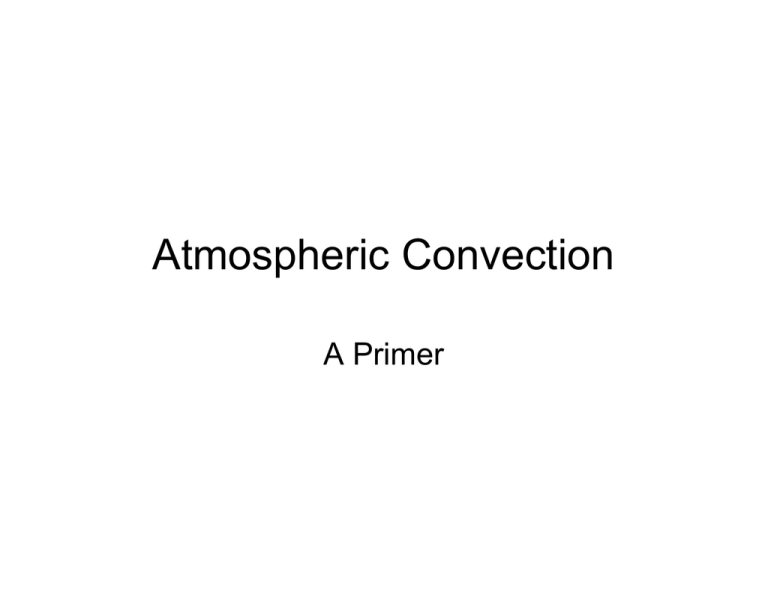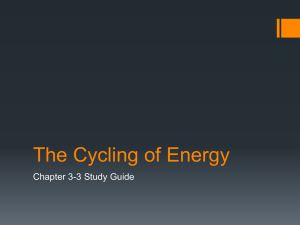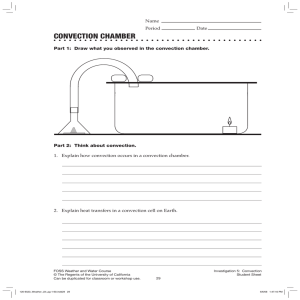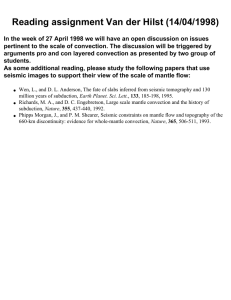Atmospheric Convection A Primer
advertisement

Atmospheric Convection A Primer Homogeneous Compressible Gases Buoyancy and Entropy Specific Volume: α = 1ρ Specific Entropy: s α = α ( p, s) ∂α ∂T Maxwell : = ∂ ∂s p p s ∂T ∂α = δ s = ∂s p ∂p B=g (δα ) p (δα ) p g ∂T α = α ∂p δ s s ∂T δ s = − δ s ≡ Γδ s ∂z s s The adiabatic lapse rate: First Law of Thermodynamics : dsrev dT dα Q =T = cv +p dt dt dt dp dT d (α p ) = cv + −α dt dt dt dT dp = ( cv + R ) −α dt dt dT dp = cp −α dt dt Adiabatic : c p dT − α dp = 0 Hydrostatic : c p dT + gdz = 0 → ( dT dz ) s =− g cp ≡ −Γ d g Γ= c p 1K Γ = Earth’s atmosphere: 100 m Model Aircraft Measurements (Renno and Williams, 1995) Image courtesy of American Meteorological Society. Prandtl’s (1925) problem Q ∞ ∫0 Qdz =F F ~ L2t −3 →w~ ( Fz ) 1 3 1 3 F2 B~ z Above a thin boundary layer, most atmospheric convection involves phase change of water: Moist Convection Moist Convection • Significant heating owing to phase changes of water • Redistribution of water vapor – most important greenhouse gas • Significant contributor to stratiform cloudiness – albedo and longwave trapping Water Variables Mass concentration of water vapor (specific humidity): q≡ MH O 2 M air Vapor pressure (partial pressure of water vapor): Saturation vapor pressure: C-C: e* 17.67(T −273) T +30 e* = 6.112 hPa e Relative Humidity: H ≡ e e* e The Saturation Specific Humidity Ideal Gas Law: R*T p=ρ m R*T e = ρv mv mv e ρ v q= ρ = m p mv e* q*= m p Phase Equilibria Bringing Air to Saturation e = qp m m v e* = e * (T ) 1. Increase q (or p) 2. Decrease e* (T) When Saturation Occurs… • Heterogeneous Nucleation • Supersaturations very small in atmosphere • Drop size distribution sensitive to size distribution of cloud condensation nuclei ICE NUCLEATION PROBLEMATIC Percentage of clouds with ice particle concentrations above detectable level 15 16 16 80 7 1 2 1 1 1 8 23 60 25 40 12 10 25 14 20 33 15 20 0 0 4 3 100 1 1 -5 -10 -15 Cloud top temperature (oC) Figure by MIT OCW. -20 -25 Precipitation Formation: • Stochastic coalescence (sensitive to drop size distributions) • Bergeron-Findeisen Process • Strongly nonlinear function of cloud water concentration • Time scale of precipitation formation ~1030 minutes Stability No simple criterion based on entropy: T p sd = c p ln − Rd ln p0 T0 α = α ( sd , p ) T p q +L − qR ln (H s = c ln − R ln p T d p vT v 0 0 α = α ( s, p, qt ) ) Virtual Temperature and Density Temperature Assume all condensed water falls at terminal velocity Va + Vc α= Md + Mv + Mc pV = nR *T R *T Va = p Md Mv + , md mv 1 md ≡ 1 Md Rd T → Va = p where ε≡ mv Mi ∑i m i M + Mv d ε md , ≅ 0.622 Rd ≡ R * md ( ) Va + Vc Rd T qc ρ a q = α= 1 − qt + 1+ ε Md + Mv + Mc p 1− qc ρc Rd T ≅ 1 − qt + q ε p Mv + Mc Mv qt ≡ , q≡ M M ( ) Density temperature: ( q Tρ ≡ T 1 − qt + α= Rd Tρ p ε ) Trick: Define a saturation entropy, s* : s* ≡ s (T , p,q*) α = α ( s*, p, qt ) We can add an arbitrary function of qt to s* such that α ≅ α ( s*', p ) Stability Assessment using Tephigrams: 100 Pressure (mb) 200 300 400 500 600 700 800 900 1000 -40 -30 -20 -10 0 10 Temperature (C) 20 30 40 50 Stability Assessment using Tephigrams: Convective Available Potential Energy (CAPE): CAPEi ≡ ∫ p (α p − α e )dp pi n ( ) = ∫ p Rd Tρ − Tρ d ln ( p ) pi p e Other Stability Diagrams: “Air-Mass” Showers: This image is copyrighted by Oxford, NY: Oxford University Press, 2005. Book title is Divine Wind: The History and Science of Hurricanes. ISBN: 9780195149418. Used with permission. Image courtesy of American Meteorological Society. Precipitation Effects: Buoyancy Reversal: Summary of Differences Between Dry and Moist Convection: • Possibility of metastable states • Strong asymmetry between cloudy and clear regions • Typically, only thin layers near surface are unstable to upward displacements • Mixing can cause buoyancy reversal • Large potential for evaporatively cooled downdrafts • Separation of buoyancy from displacement can lead to propagating convection • Buoyancy of unsaturated downdrafts depends on supply of precipitation • Entropy produced mostly through mixing, not dissipation • Internal waves can co-exist with unstable convection Tropical Soundings Annual Mean Kapingamoronga: Radiative-Moist Convective Equilibrium Precipitating Convection favors Widely Spaced Clouds (Bjerknes, 1938) This image is copyrighted by Oxford, NY: Oxford University Press, 2005. Book title is Divine Wind: The History and Science of Hurricanes. ISBN: 9780195149418. Used with permission. Properties: • Convective updrafts widely spaced • Surface enthalpy flux equal to vertically integrated radiative cooling c pT ∂θ = −Q M • θ ∂z • Precipitation = Evaporation = Radiative Cooling • Radiation and convection highly interactive 5 4.5 Pre cipita tion (mm/da y) 4 3.5 3 2.5 2 1.5 1 0.5 0 1 2 3 4 5 6 Time (days) 7 8 9 10 This image is copyrighted by Academic Press, NY, 1999. It is in a chapter entitled "Quasi-equilibrium Thinking" (author is Kerry Emanuel) that appears in the book entitled General Circulation Model Development: Past, Present and Future. Edited by D. Randall. ISBN: 9780125780100. Used with permission. This image is copyrighted by Academic Press, NY, 1999. It is in a chapter entitled "Quasi-equilibrium Thinking" (author is Kerry Emanuel) that appears in the book entitled General Circulation Model Development: Past, Present and Future. Edited by D. Randall. ISBN: 9780125780100. Used with permission. This image is copyrighted by Academic Press, NY, 1999. It is in a chapter entitled "Quasi-equilibrium Thinking" (author is Kerry Emanuel) that appears in the book entitled General Circulation Model Development: Past, Present and Future. Edited by D. Randall. ISBN: 9780125780100. Used with permission. This image is copyrighted by Academic Press, NY, 1999. It is in a chapter entitled "Quasi-equilibrium Thinking" (author is Kerry Emanuel) that appears in the book entitled General Circulation Model Development: Past, Present and Future. Edited by D. Randall. ISBN: 9780125780100. Used with permission. Recovery from mid-level specific humidity perturbation Specific humidity perturbation (g/Kg), from -5.479 to 2.645 -100 -200 -300 P (mb) -400 -500 -600 -700 -800 -900 -1000 1 2 3 4 5 6 Time (days) 7 8 9 10 Tv Perturbation, from -6.87 to 0.848 -100 -200 -300 P (m b) -400 -500 -600 -700 -800 -900 -1000 1 2 3 4 5 6 Time (days) 7 8 9 10 Robe and Emanuel, J. Atmos. Sci., 1996 Image courtesy of American Meteorological Society. Islam et al. Predictability Experiments Robe and Emanuel, J. Atmos. Sci., 2001 Image courtesy of American Meteorological Society. Fovell and Ogura, J. Atmos. Sci., 1988, 1989 Image courtesy of American Meteorological Society. Rotunno, Klemp and Weisman, J. Atmos. Sci., 1988 Image courtesy of American Meteorological Society. Speculative Regime Diagram 2-D Shear-Parallel Convection E, zb 2-D Shear-Perpendicular Convection 3-D Convection /DU/ Figure by MIT OCW. Non-equilibrium Convection Desert Low qe Gulf of Mexico High qe Figure by MIT OCW. Klemp and Wilhelmson, J. Atmos. Sci., 1978 Image courtesy of American Meteorological Society.




